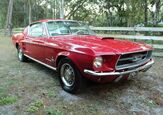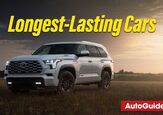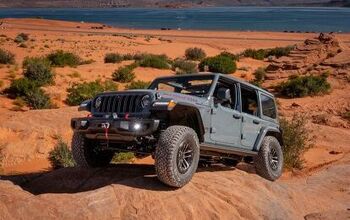Off-Road Shootout: Toyota Land Cruiser vs Ford Bronco vs Jeep Wrangler

We had to do it: collect three iconic off-roaders to play in the mud.
The impetus for this day of adolescence? Toyota reviving the Land Cruiser name on these shores—after a few years’ absence in America and whole decades in Canada. The big T has hailed this as a lighter, smaller, (comparably) more affordable, and even more efficient version of the Cruiser, yet in this company, it remains the sophisticated choice.
That’s because editor Mike Schlee has rumbled up in a Jeep Wrangler Rubicon 392. The Wrangler is the polar opposite of the Land Cruiser: bright Tuscadero pink paint, a 6.4-liter V8 nearly three times the displacement of the Toyota’s hybrid setup, and loud as hell.
The final member of the trio isn’t for shrinking violets either. The Ford Bronco 2-Door Heritage Limited Edition is the picture of retro off-roaders done right in this baby blue paint. On paper, it sits somewhere between the calm Cruiser and raucous Wrangler.
This isn’t a strict comparison, but rather a look at what each brand’s respective range-topper offers, and if they live up to those historic nameplates.
Now, time to get dirty. This off-road shootout is brought to you by Weathertech.
2024 AutoGuide.com Off-Road Shootout: All The Details
The Iconoclast: Jeep Wrangler Rubicon 392
Do you hate your neighbors, the serene sounds of nature, and love attention? Well this, friend, is the SUV for you. The Rubicon 392 is the ultimate version of the ultimate Jeep, an exercise in excess that has seen a stay of execution to continue burbling all across the land. Stellantis didn’t stick a Hellcat in here, but we’re still talking about a V8 Wrangler that can out-accelerate a ‘90s Viper… on A/T tires.
Jeep Wrangler Rubicon 392 Features
Befitting its role as the top dog, the 392 has everything an experienced off-roader could reasonably want right from the factory. It includes 17-inch, beadlock-ready wheels wrapped in monstrous 315/70 tires, front and rear locking diffs, a front sway bar disconnect, and a dedicated off-roading infotainment page. Don’t forget the obvious two-speed transfer case, or such niceties as hill descent control. And now, a winch!
All that to say, the Wrangler isn’t a one-trick pony anymore. There are power-adjustable front seats, a small feat considering this thing’s wading depth, but also to be expected with a six-figure price tag. The native navigation is easy enough to use, and there’s a—shock, gasp—fully functional and useful driver assistance suite. On top of all this, literally, is the one-touch Sky Roof, which gives the whole cabin an open-air experience without the hassle of Legoing the whole top half of the Jeep apart.
Schlee praises the usefulness of the cabin. Not just Uconnect, which is still the best of the bunch on its fifth iteration, but the sheer number of physical buttons Jeep has kept. It’s easy to activate anything on muscle memory alone, and there’s four additional auxillary switches should you want to go further still. At this price, we’d both like to see seat ventilation and wireless charging—though given what the Wrangler is capable of off-road, the latter wouldn’t be of much use.
The Wrangler still isn’t what you’d call the easiest daily driver, but it’s come a long way even in just the last decade.
Jeep Wrangler Rubicon 392 Powertrain and Handling
Naturally, the engine is the star here: just about everything else can be had on a regular Rubicon, after all. The 6.4-liter V8 throws down a faintly ridiculous 470 horsepower and 470 pound-feet of torque, coursing through the usual eight-speed auto. With a switchable exhaust, you can keep it in loud mode all the time for the most glorious soundtrack of the trio. This is the real American sports car.
Of course, it’s thirsty as can be. But look, nobody is buying this not expecting as much. Given its massive power advantage, the Wrangler is arguably comparatively efficient. Yeah, let’s go with that.
On the trails, the Wrangler is hilariously over-qualified, like Stephen Curry jumping into the neighborhood pick-up game. We don’t even need to use most of those available features, only waking up the front-facing camera to ensure it clears some of the tighter sections. Even the gnarliest climb is dispatched in basic 4-Auto. Its major hindrance is the sheer length of the thing, turning tighter corners into delicate, three-point affairs.
Wranglers catch a lot of flak for being vague and barn-like to drive on the road, but the important thing here is that off-road it is in its element. Is there a lot of play in the steering? Sure is. But that allows the driver to easily make small adjustments. The brake pedal is a similar story: squishy on tarmac but easy to judge off-road. The Wrangler makes its driver feel like a superhero.
The Cool Guy: Ford Bronco Heritage Limited
In many ways, the Bronco matches up with the Wrangler. Same 11.6 inches (295 millimeters) of ground clearance, same exact tires, same focused approach on being utterly accomplished off-road. While something like an Everglades or Raptor would be more in spirit with the Jeep’s over-muscled approach, this particular Bronco does what the Blue Oval has been nailing for so many years of Mustang: capturing the spirit and look of yesteryear’s models without sacrificing much in the way of modern features.
Ford Bronco Heritage Limited Features
The Bronco’s cabin is easily the best-looking of the bunch, with wicked-cool brown leather seats featuring contrast stitching. There are splashes of the pastel blue on the doors, and another brown framing the dashboard, which goes white like the exterior grille. Capping it all are small flashes of orange highlights. It sounds like a lot on paper but in practice it’s such a fun, welcoming space. The Wrangler and Land Cruiser are caves by comparison.
The Heritage Limited represents the absolute peak of the two-door lineup, with the inherent advantages (maneuverability) and disadvantages (accessibility) that layout provides. Access to the back seats isn’t coupe awful, mind you: since the Bronco is so big-boned, the front seats slide well forward, and the back row is nearly as spacious as the one in the Jeep. Well, except the Bronco is a strict four-seater, not five.
Bronco buyers don’t get left out from modern conveniences either. Adaptive cruise control works well here, and there’s a heated steering wheel and front seats. The sound system pumps out impressive tunes, and proved a great choice for a night at the drive-in. But at this elevated price tag, missing power-adjustable front seats feels mean.
Like the Wrangler, there’s a good amount of physical controls for the climate and audio, so that’s a win. Ford’s SYNC 4 infotainment is very slick in its presentation, as is the digital instrument cluster. It’s not quite as responsive as the others, but we both appreciate its straightforward approach.
Ford Bronco Heritage Limited Powertrain and Handling
The Bronco splits the difference between the eight-cylinder Jeep and four-cylinder Toyota. A 2.7-liter turbo V6 puts out 330 hp and 415 lb-ft when drinking the good stuff; it’ll handle regular fuel too, but you’ll see drops of 15 and 5, respectively. The soundtrack is appropriately gruff and honestly, after the Jeep it’s almost relaxing to make progress without attention. Off-the-line responses aren’t as sharp as the electrified Toyota, but they feel appropriate, and the Bronco doesn’t run out of steam at any time.
Ford’s 10-speed auto has earned dings from us in the past for its constant gear hunting. There isn’t much of that here though, with the worst aspect being its occasional reluctance to kick down for passing on the highway. Which, uh, isn’t a problem out here…
With its tidy footprint, the Bronco is the easiest of the three to place on the trail. Not only does it make tight corners, visibility is excellent, including a clear view of the roof from those big side mirrors, which is handy when clearing low overhanging branches. I love the front hood tie downs, not just for their inherent use but because they work as easy guides to know where the nose ends. Like the Wrangler, the Ford rolls with nearly a foot of ground clearance, so little rocks pose zero challenge. Should an errant rock make a break for the undercarriage, there is solid protection for the most important bits.
The Bronco’s a great partner on the trail. It’s not remotely challenged by this one either, like the Jeep, but it’s got slightly better manners. Thank the independent front suspension for that, which blesses the Bronco with a cleaner, more direct steering feel. Overall, the Bronco is a friendlier, (slightly) more modern take on the classic off-roader formula.
The Rational One: Toyota Land Cruiser First Edition
We won’t tap-dance around it: coming into this, we knew the Land Cruiser would be the least capable off-road. We’ve already taken it up a mountain, after all—and that was on aftermarket tires. This First Edition rolls on more road-friendly rubber, plus It has the least ground clearance, and the worst approach and departure angles.
Can it match the extremes of the others? Of course not. But this reborn Land Cruiser can accomplish most of what most people will need, and does it in an altogether more daily-friendly package.
Toyota Land Cruiser First Edition Features
Getting out of either of the two Americans and into the Land Cruiser makes you feel like you need to lift your pinkie. It’s sophisticated, classy—at least, comparatively. There’s plenty of sound deadening to keep the ride quiet, the seats are cushy, mega-adjustable, and feature both heating and ventilation. Memory seating is also most welcome.
If only it looked swankier. The Cruiser interior is a sea of black, and not all of it feels up to par for this pricey truck. There’s lots of plain black plastic on the doors, where you’ll also find one of the few First Edition signifiers: squint and you’ll make out the unique padding.
Like the others, the Land Cruiser goes big on physical controls, aping the Prius by aligning two rows on different planes, keeping them close and avoiding taking up too much space. Toyota’s touchscreen is generally good too, though we still don’t like the extra pokes having to switch between the native setup and the (wireless) Apple CarPlay and Android Auto.
Adding to the practical nature of the vehicle, it has a huge storage area, though folding the seats leaves an odd hump, so longer items will sit awkwardly.
It’s not as if the Toyota misses out on the purposeful bits of the others either. It has a sway bar disconnect, it has locking diffs. Toyota’s drive modes, multi-terrain select, and downhill assist are all here and all conveniently found on the same rotary dial/button combo.
Toyota Land Cruiser First Edition Powertrain and Handling
The Land Cruiser comes with just one powertrain choice on this side of the Pacific: a 2.4-liter inline-four hybrid setup. It’s the same one we’ve seen in the Tacoma, and will soon see in the very similarly-sized 2025 4Runner. Horsepower is fractionally lower than the Bronco at 326 hp, while torque nearly matches the Wrangler at 465 lb-ft.
On the trail, the Bronco and Land Cruiser offer similar levels of grunt, but in a surprise, it’s the Toyota that is easier to modulate in the low-speed stuff. The electric assist is clutch here, and Toyota’s engineers have put in work to ensure the pedal is smooth and easy to judge.
The Land Cruiser’s two most limiting factors are its ground clearance and its soft-roader tires. You can fix the latter easily enough, but the former will be a bit more involved. Stock, it handles everything we throw at it, though it requires more careful route consideration up the rock-strewn main climb. There’s underbody protection, but it isn’t as ample as you’ll find in the others.
Verdict: Toyota Land Cruiser vs Ford Bronco vs Jeep Wrangler
“After many days off-roading and on-roading with these three SUVs, I think the Wrangler really lives up to its nameplate,” says Schlee after all is said and done. It’s never really changed, after all: now it’s just got a V8 monster under the hood.
Similarly, even though it was gone for decades, the Bronco feels like a natural evolution of the badge. It’s still got a sense of adventure, it’s still relatively easy to remove the roof for open-air fun, and it’s still got better manners than the Jeep. But oh boy is it pricey.
Meanwhile, the Land Cruiser is an anomaly. Toyota has consciously broke from the Lexus-in-all-but-badge approach of the last one, but as this round-up shows, it’s far from a glorified tractor. Instead, it’s forging its own path… just in the brush, away from all the big rocks.
At the end of the day, we all had our favorites. Schlee can’t resist the lure of a big, burbly V8—he’s got a type, after all—and money no object, who can argue? The 392 is rolling threater, the type that you can take up a mountain. For me, the surprise was the Bronco. It looks cool as can be, and it’s a bit better to drive than the Wrangler. The Ford wasn’t even that much thirstier than the hybrid ‘Yota.
Yet the Land Cruiser earned respect. The camera team loved it—no surprise, as it is the most practical—and both Mike and I acknowledge that most people won’t actually use all of the capability of any of these. To live with, day to day, year to year, this is the ideal choice.
Become an AutoGuide insider. Get the latest from the automotive world first by subscribing to our newsletter here.

Kyle began his automotive obsession before he even started school, courtesy of a remote control Porsche and various LEGO sets. He later studied advertising and graphic design at Humber College, which led him to writing about cars (both real and digital). He is now a proud member of the Automobile Journalists Association of Canada (AJAC), where he was the Journalist of the Year runner-up for 2021.
More by Kyle Patrick












































Comments
Join the conversation
Wrangler 392 all day. The Turbo in the Ford will blow up in a few years, and the Hybrid Land Cruiser is a grocery getter.
Having wheeled now for more than 60 years building up with lockers, lift and gearing 25 years ago to access so called badge trails before there were "badges" 🥱; in my since stolen $1500 '87 XJ, none of these offer anything I want. The Cherokee was athletic, durable, capable, spacious, economical, simple, trail repairable and efficiently useful. The vulnerable serenity, beauty, challenge, risk and sheer sport of remote wheeling is disappearing with the oncoming crush of these, look-how-much-money-I-have; I-didn't-have-to-build-this exhibitions of Thorstein Veblen displays.